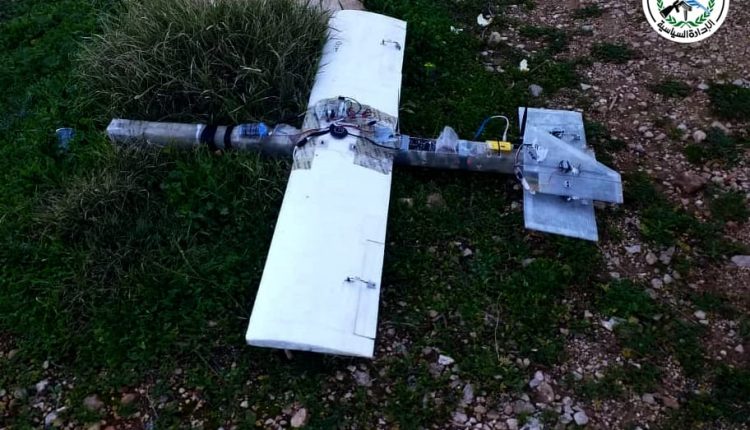By Lamar Arkandi
IDLIB, Syria (North Press) – Observers believe that the suicide drones taking off from areas under the control of Hayat Tahrir al-Sham (HTS – formerly al-Nusra Front) in Idlib Governorate, northwest Syria, targeting both civilian and military objectives, serve as messages to the conflicting parties.
These drones may not be technologically advanced, but their use concerns Russia, Syria, and Iran about the HTS’s defense system. This raises significant questions about how the HTS acquired these drones and the possibility of owning specialized factories to manufacture them within its controlled areas in Idlib.
After investigations, exclusive sources told North Press that the HTS has a factory in the town of Ain al-Beida, north of Latakia, on the Syrian coast, which was formerly a school and converted into a factory for manufacturing drones.
Uighur Design and Manufacture
The sources emphasized that the design and manufacturing of these drones are carried out by engineers of Uighur origin. They also known as the Turkistan Islamic Party, who are jihadists that arrived from their homeland in China with their families in 2013 and settled in the coastal mountains and the western countryside of Idlib.
These individuals are responsible for designing and overseeing the manufacturing of these drones. The sources noted that they receive salaries that may amount to over $4000 monthly.
The workers in the factory, hail from various nationalities, including Syria, are jihadists and affiliated with several extremist factions, with a third of them having ties to the Islamic State (ISIS) and working under the supervision of Uighur experts.
Regarding the possibility of the HTS owning a factory for manufacturing suicide drones, Majed al-Qaisi, a military analyst, did not rule out the existence of such factories.
Al-Qaisi told North Press that ISIS previously owned factories manufacturing drones in Syria and Iraq, especially that they are cheap.
Al-Qaisi noted that the most advanced ones cost around $1,000. “These drones can be manufactured locally, as their equipment is available in the local market, and those factions, including the HTS, have engineers and experts in this field. Lucrative salaries are offered to them to develop military capabilities through these drones,” he stated.
These drones can be manufactured anywhere _ in a school, a large house, a warehouse, or any facility _ as manufacturing these drones only requires an expert and certain materials, according to al-Qaisi.
“Hitting targets precisely”
Al-Qaisi pointed out that all armed factions possess such drones to maintain influence over the territories they control.
Al-Qaisi stated that these drones have become the effective tactical tool for the factions to compensate for the shortage of artillery or mortars that their launching range does not exceed four to six kilometers, while those drones fly long distances, “hitting targets precisely”.
Warnings and Concerns
Regarding the danger of terrorist groups using suicide drones, Saud al-Sharafat, a former Brigadier General in the Jordanian General and Chairman of the Shorufat Center for Globalization and Terrorism Studies in Amman, believes that the fear of terrorist groups employing advanced technology such as drones deeply troubles countries and counter-terrorism institutions worldwide.
He noted, in an interview with North Press, that terrorism studies experts and academics warned about that danger.
“The HTS possession of the capability and resources to manufacture such diverse and efficient drones is considered a significant milestone in the structure of terrorist groups, with the HTS at the forefront,” al-Sharafat stated.
Al-Sharafat highlighted the implications of this issue and its direct repercussions on the armed conflict in Syria, which falls under the supervision of the conflicting parties, particularly Turkey.
“I believe that Turkey will be more careful and cautious about this development in the future. Therefore, it will make efforts to control this.”
Ahmad Sultan, a researcher in terrorist groups affairs, believes that it will be in the Turkey’s interest if the defense system of the HTS develop because the HTS has become Ankara’s primary and the closest ally at the expense of other Turkish-backed factions.
Sultan told North Press that Turkey did not allow the HTS to possess and develop suicide drones unless that matter was in its interest.
Targeting Iranian Embassy and Military Academy
Areas controlled by the Syrian government and adjacent to areas controlled by the Syrian opposition have become targets for drone strikes resulting in both material and human losses.
However, the most fierce targeting was the attack that targeted the Military Academy in Homs Governorate, central Syria, late 2023, resulting in the killing of at least 110 individuals and injuring 125 others. That occurred during a graduation ceremony for officers. The Syrian government attributed the attack to terrorist groups.
The second attack was the targeting of the Iranian Consulate in Aleppo Governorate, northwestern Syria, causing material damages to the building.
In a related context, al-Qaisi explained that the drones took off from the outskirts of Idlib, crossed Hama, and struck the Military Academy in Homs.
At the time, Syria’s Ministry of Defense announced dropping eight drones in the countryside of Hama and Aleppo, resulting in the killing of three Syrians and injuring two others.
Additionally, Vadim Kulit, Deputy Chief of the Russian Reconciliation Center based in Khmeimim Air base, announced the destruction of a warehouse for drones in Idlib by Russian Air Forces.

